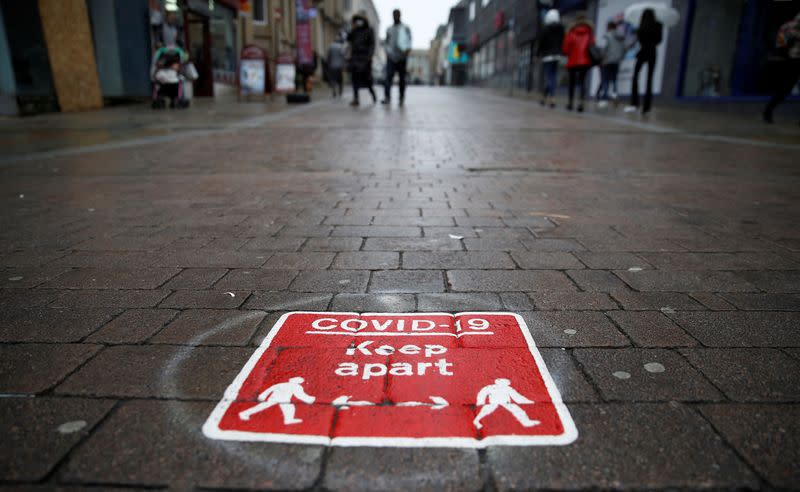Riding the CoronaCoaster of UK rules

By Steve Stecklow
LONDON (Reuters) - In the beginning, there was "Stay at Home. Protect the NHS. Save Lives."
That was the British government's simple slogan for its country-wide lockdown that began in March to try to stem the COVID-19 pandemic and avoid a collapse of the National Health Service's hospital system.
Nothing has been simple ever since.
In the ensuing months, the original slogan has been replaced by a series of new catchphrases, the "Rule of Six," a "Tiers" alert system, and ever-changing regulations for different parts of the United Kingdom that even British Prime Minister Boris Johnson recently called "confusing."
"I like to follow the rules," says Joinal Abdin, 41, who lives near Oldham, in northern England. Does he understand them? "No. Half of the time I'm confused, to be honest with you."
Even before restrictions eased in early summer, "Stay at Home" became "Stay Alert." July saw the introduction of "Wash Hands. Cover Face. Make Space."
The new slogan didn't explain exactly how much space. The government had reduced the original two-metre social-distancing rule to something called "one metre-plus." People were told it was now safe to keep a distance of just one metre – provided one wore a mask or face shield.
Unless you lived in Wales, that is. There, the two-metre rule remained in effect.
As Britain tried to return to some semblance of normality over the summer, the four nations that comprise the UK – England, Wales, Scotland and Northern Ireland – each established its own COVID-19 regulations. The rules varied from town to town as authorities tried to target specific hot spots.
For example, as cases surged in the northern town of Bolton in September, its pubs only were allowed to sell alcohol on a takeaway basis. Many just closed their doors.
But one pub with a Bolton postal code was open and bustling when a Reuters journalist visited on September 23. That's because The Queens sits just over the boundary with another town, Bury, where pubs were still allowed to have sit-in customers.
The Queens' customers that day included the manager of The Queen Anne, a Bolton pub just a four-minute drive away that was closed, and many of his regulars.
HUNTING GROUSE
To assist restaurants, the government in August had introduced the "Eat Out to Help Out" scheme, in which it picked up half the tab for eating out, up to 10 pounds ($13) per person. The program was wildly popular – more than 100 million meals were subsidized at taxpayers' expense.
But by late September, after COVID-19 cases started rising throughout England, all restaurants there were ordered to close by 10pm. The virus was now believed to be spreading inside some dining outlets.
The government that month also established the "Rule of Six," which stipulated that any social gatherings of more than six people were illegal and punishable by fines and possible arrest.
Restaurants could continue to host more than six customers. So, for that matter, could grouse-shooting parties, places of worship, gyms and pubs. "Within those venues, there must not be individual groups larger than six, and groups must not mix socially or form larger groups," the government's website said.
Even the prime minister was confused about how the "Rule of Six" applied to different regions, as well as indoors and outdoors. On Sept. 29, Johnson was asked whether people in northeastern England were allowed to meet up with other households in outdoor beer gardens. "In the North East and other areas where extra tight measures have been brought in, you should follow the guidance of local authorities, but it's six in a home or six in hospitality but, as I understand it, not six outside," Johnson said.
He soon issued a correction on Twitter: "Apologies, I misspoke today. In the North East, new rules mean you cannot meet people from different households in social settings indoors, including in pubs, restaurants and your home. You should also avoid socialising with other households outside."
By mid-October, the UK's slogan had changed yet again – to "Hands. Face. Space."
The government also introduced a new three-tier alert system for England in which different places were assigned different rules based on infection rates. The tiers carried medium, high and very high alert levels.
In Liverpool, which was designated the very high alert level, pubs and restaurants were ordered to close. In London, which was assigned the high level, they could stay open, but any indoor mixing of households was banned.
Meanwhile, Scotland announced in October it was implementing its own alert system – with not three, but five different tiers, beginning at "COVID protection level 0."
On Nov. 5, England suspended its three tiers and entered a new four-week lockdown. Wales had taken a similar action on Oct. 23. But it lasted only 16 days and wasn't called a lockdown. The Welsh labeled it a "firebreak."
(Reporting by Steve Stecklow; additional reporting by Andrew R.C. Marshall; editing by Janet McBride)


